When a garage door opens a little and then stops, it can be pretty frustrating.
There could be a few things that could be causing the problem. A clogged track, loose cable, broken motor, malfunctioning sensor, and broken spring can be the main reasons a garage door is not working properly. If you notice any of these signs and symptoms, you can use this site to help diagnose and fix the problem.
Another reason can be the garage door opener is malfunctioning or not installed correctly. So first, make sure that the garage door is properly aligned and installed correctly.
If the door isn’t aligned properly, the garage door opener may not be able to fully extend or retract the cable. Additionally, if there’s something blocking the path of the garage door opener’s cables, it may cause the doors to stop closing or opening. Sometimes, a small object can get caught in the moving cables and cause them to malfunction.
When your garage door is not opening and closing properly, it can lead to dangerous falls, nuisance noise, and lost time.
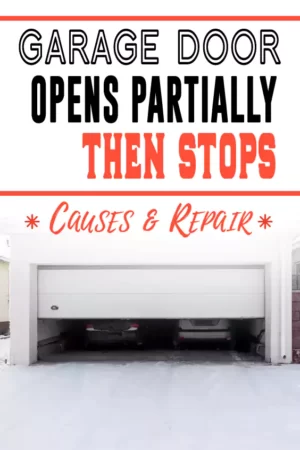
Reasons Why a Garage Door Opens a Little Bit and Then Stops
1. Clogged Up Tracks
If your garage door isn’t working correctly, then it’s likely that dirt or debris is obstructing its path. Check along its track for such obstructions; try to dislodge any that you find.
The best way to deal with a clogged track is to clean it out using warm water and soap. However, make sure you dry off these components entirely before trying to open the door again.
2. Loose Cables
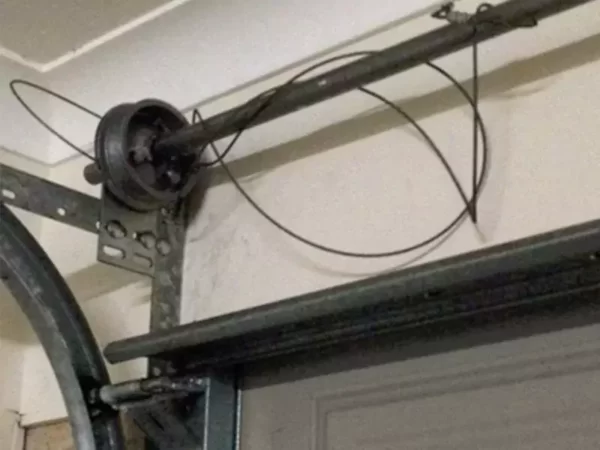
Loose cables can cause your trolley system to get hung up when you open your garage door; so the doors will stop halfway.
Often, simply tightening loose screws can get things moving again without investing in a significant repair.
If those solutions don’t work, you may need new cables entirely. A little preventative maintenance can help avoid an expensive repair later in either case.
3. Broken Motor
A broken motor can cause your garage door to move only partway.
If you hear buzzing, rattling, or squealing noises when opening your garage door, there may be an issue with your motor.
One of the likely causes is a broken or loose wire. There are no easy fixes here; your best bet is to contact an expert to repair or replace the motor.
4. Malfunctioning Sensors
One of your opener’s safety sensors might have been jarred loose or tripped by something. The sensor will trigger a “door not detected” error if it is out of place.
Check each sensor to make sure they are securely attached and clean. If you notice any physical damage, have the sensors replaced immediately before proceeding.
Once repaired, adjust your stop limit for each sensor so that your door runs smoothly again.
5. Stripped Gears
If your garage door opens a little but suddenly seems to get jammed, it could be that one of its wheels has stripped gears.
A stripped gear is essentially where the track has broken away from its mating part. As a result, it doesn’t have enough power to push or pull the door open or closed.
The problem may be fixable or may require replacement.
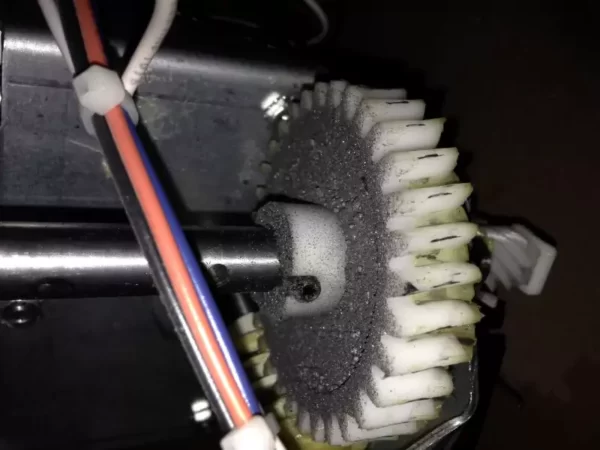
6. Incorrectly Set Up Opener Remote Control
The remote control may be set up incorrectly to not transmit or receive signals from your opener.
To fix it, check your opener’s user manual to find out how to set up your model’s remote control correctly.
If that doesn’t help, try using another remote if you have one, just in case yours is not working correctly. And if that doesn’t work either, replace your battery with new ones.
7. Misaligned/Dirty Photo Eye
The photo-eye is an infrared sensor, which monitors whether or not there is something in its field of vision.
If you’ve noticed that your garage door only opens a few inches and then stops, check to ensure debris isn’t blocking or dirtying up its photo-eye.
And if it’s misaligned, you may be able to fix it by adjusting or realigning it manually. Many openers have their manuals with instructions on how to do so.
8. A Malfunctioning Logic Control Board
One common reason why a roller garage door opens a little and then stops is because of a faulty logic control board.
The logic control board communicates with your remote to deliver signals to the door system and ensure optimal operation.
Repeated use can lead to a worn-out logic control board, which will need to be replaced to restore full functionality to your garage door opener.
9. Broken Springs
Your door springs are what move your system. If these parts are old or broken, they can fail without warning. As a result, it can cause your door to open only partially and then stop.
If you find yourself with a broken spring, be sure to replace it or call an expert. I once saw that my garage door opened six inches and then stopped suddenly. Springs were the issues there.
10. Bent Track
Last but not least, the cause for your malfunctioning garage door is bent tracks. The tracks are what support your door.
If they are bent or misaligned, your entire opener can be thrown off, causing your door to stop halfway when opened.
Examine them from different angles as you open and close your garage door to tell if they are warped.
Here’s How I Fix a Garage Door That Opens a Couple of Inches or Foots then Stops
Step 1 – Check for Obstructions
If your garage door won’t open, there’s probably something blocking its motion. You should check several things before moving down to the next steps.
Examine your springs, cables, tracks, safety eyes, etc., obstruction.
If you can move them with your hand freely, check under and around them for debris that could be interfering with their function.
Step 2 – Check All Cables, Springs, and Wires
Before replacing any parts, it’s essential to ensure all cables, springs, and wires are correctly connected. Look at each piece individually before you remove anything.
First, you can try releasing some tension by removing springs and pulleys if your door has them. On your track, look for broken wheels and replace them as needed.
If they are in good shape, move on to the cables. If they’ve snapped or frayed over time, it’s time to replace them.
Step 3 – Test the Circuit Board
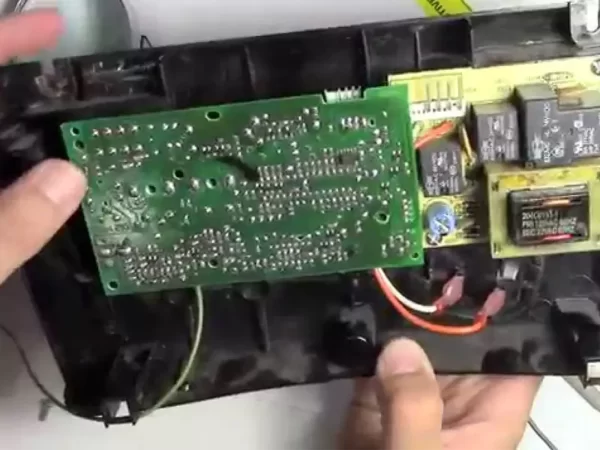
The circuit board is one of the most critical components in your motor. Any problems with it can spell disaster for your door system’s efficiency.
If you still can’t get your automatic door working, the chances are that your circuit board needs to be replaced.
But first, get it tested to determine its functionality. The best way to test a circuit board is with an ohmmeter or a multimeter*. A multimeter gives you an immediate reading on electrical conductivity inside your motor’s unit.
Step 4 – Test the Safety Sensors
If your garage door is acting up, another possible culprit could be faulty sensors. Safety sensors stop a door from going all of the way up when an object is in its path.
If you find that one sensor isn’t working, pull up on it and check if any debris interferes with its motion. Remove any debris by hand.
Once you remove the debris and inspect the part, it may still not work. In this case, you’ll either need to replace your sensor fully (follow the instructions supplied with your purchase) or seek expert help.
Step 6 – Test Your Motor
Most often, when your garage door is only opening partway, it’s because your motor is worn out. To test it, do the following.
Manually rotate it, then test it with a multimeter, open the inside door panel and spin the shaft while someone listens for noise outside.
If your motor doesn’t spin freely at any point in its range, it is likely damaged.
Step 7 – Check the Remote
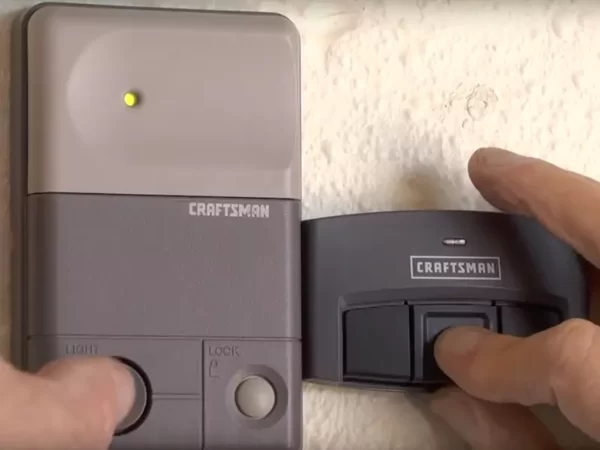
A faulty remote can also cause a chain reaction, causing your garage door to shut down before it has fully opened.
To diagnose what’s gone wrong, begin by ensuring your remote is working correctly, without interference. Next, check to see if your remote batteries are dead.
If they are functioning correctly and still won’t work, you may have an issue with your receiver.
The receiver interprets signals from its corresponding remote control to allow you to open and close your garage door safely. So if it is broken, it will not respond even when nothing is blocking its path.
Step 8 – Lubricate the System.
Lubricating the entire door system is an essential step in ensuring your door opens and closes with ease.
Remember that excess friction generates heat, which causes irreversible damage. So periodic maintenance is helpful in the long run.
To lubricate your door, open it up and clean, grease, and replace any deteriorated parts that are obstructing its movement.
Pay attention to cables, hinges, guide rails, and every part of the door.
Final Step – Reset Your Circuit Breaker and Test the Opener
If your garage door doesn’t go up after you have already gone through steps 1-8, you probably need to reset your circuit breaker.
A lousy circuit breaker is often at fault for any number of problems with your automatic garage door opener.
To reset your circuit breaker, flip it off and on again at your house’s main electrical service panel.
After making sure your circuit breaker is working correctly, test your automatic opener by pressing its remote control button once more.
4 Reasons Why a Garage Door Won’t Open All The Way in Cold Weather
If your garage door isn’t working properly, the following could be the problem.
1. Ice on Sensors
The sensors can freeze in cold temperatures, interfering with signals that control your garage door. As a result, your door will only close or open partially.
If its winter time and ice forms on your garage door, scrape it off with a scraper. Check and clean your sensors regularly using alcohol.
2. Compressed Air Supply
Cold air can make it difficult for springs to contract enough to lift your garage door. If your garage door opener stops and reverses at a specific point, consider warming the springs with heated tap water. Heat can help with spring tension by adding pressure.
Also, consider purchasing compressed air to maintain extra pressure going into those springs. Consequently, this could save you from manually compressing them regularly.
3. Frozen WeatherSeal
The weather seal keeps air and moisture out of your garage, which prevents mildew and helps keep things dry.
However, if left unmaintained, ice will form on the rubber seal and prevent it from flexing back and forth correctly. When that happens, it causes resistance and makes opening or closing the door much harder.
To avoid ice formation, properly clean and lubricate both sides of your weather seal before each winter.
4. Frozen/Low Grease
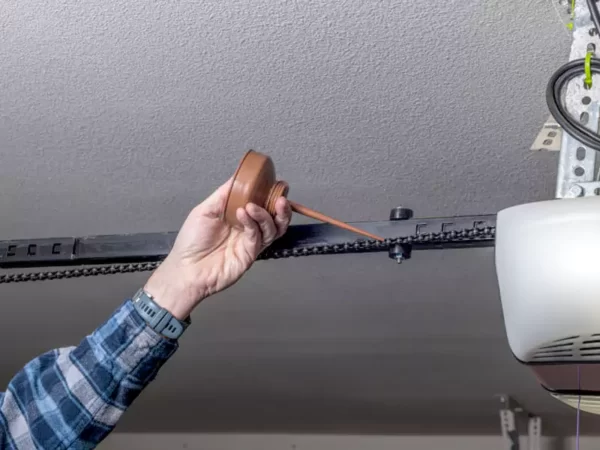
In cold weather, lubricants can become stiff, preventing your garage door from opening all the way.
When it’s cold outside, grease buildup will freeze at low temperatures. The metal shaft connecting to your garage door opener becomes stuck as it refreezes repeatedly.
You can, however, use synthetic grease instead of your regular lubricant. Synthetic oil is preferred because it works in cooler temperatures. Alternatively, you can add a solvent to the grease to make it less stiff.
Repair Cost of Garage Door Opener
Every homeowner has dealt with the frustration of their garage door opener malfunctioning at least once.
Repairing one can be a costly endeavor, especially if you don’t know the process or haven’t prepared yourself with the right tools.
Troubleshooting a garage door opener before searching for an online deal is paramount. It helps you understand just how much it will cost to repair your door opener.
That’s said, you’ll find that the cost varies greatly depending on the brand and type of opener you have.
The average cost of repairing an electric garage door opener that opens a little then stops and reverses can range from $140 to $250.
Keep in mind, too, that costs like these are variable depending on where you live and whether or not it’s simply an issue with mechanical failure or if something more serious is at play.
Regardless, if you are overwhelmed and find yourself in need of emergency repairs for any reason, don’t hesitate to contact an expert.
It’s essential to remember that garage doors sometimes exhibit traits that seem odd but aren’t a big deal. And given the intricacy of door mechanisms, this is especially true.
If your garage door opens a little and then stops or closes through its travel, there could be several reasons why.
You might have an issue with something as simple as a damaged sensor or improperly adjusted springs or as complicated as an obstruction jamming or blocking your door.
Whatever the problem is, don’t force anything if you can’t diagnose and repair the door on your own.
*Paid Link: As an Amazon Associate, I earn from qualifying purchases. Should you decide to purchase a tool through this link, I will get a small commission. The price of the tool won’t be any different to you.
Recent Posts
Many DIY lovers and engineers want to build something cool in their garages. What's cooler than a kit airplane? In this setup, the builder receives parts and puts them together in their own space....
Diamond blades have various uses, from cutting tiles and glass to cutting gems and semiconductor materials. If you’re planning to start a renovation or building project, you’ll need a diamond...
